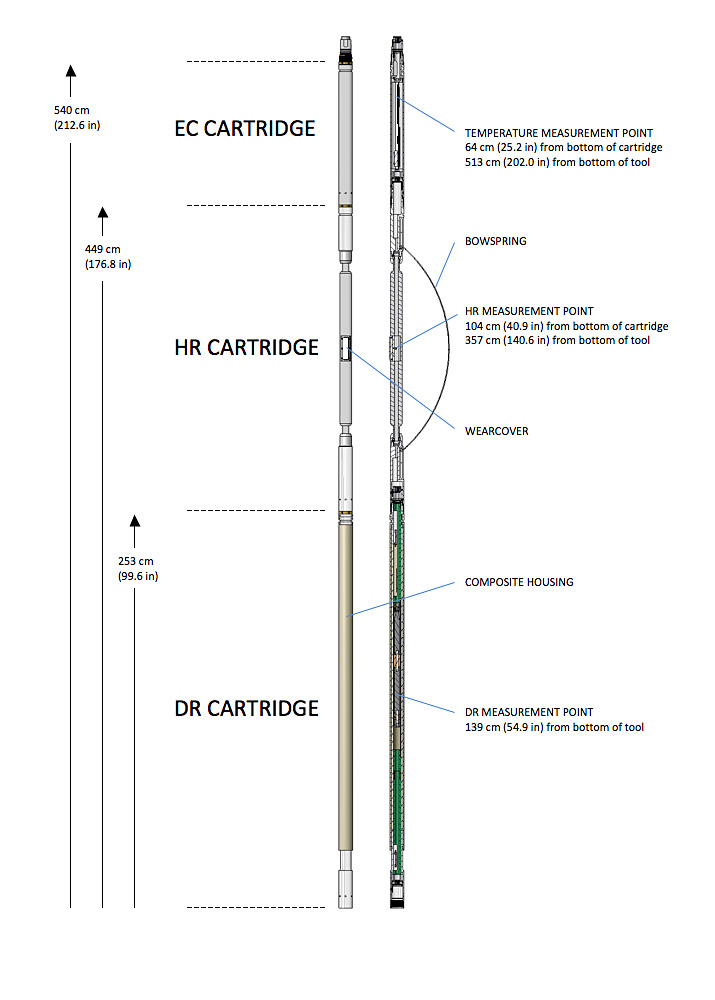Magnetic Susceptibility Sonde (MSS-B)
Description
 The Magnetic Susceptibility Sonde version B (MSS-B) is a wireline logging tool that measures borehole magnetic susceptibility at two vertical resolutions and depths of investigation.
The Magnetic Susceptibility Sonde version B (MSS-B) is a wireline logging tool that measures borehole magnetic susceptibility at two vertical resolutions and depths of investigation.
The tool incorporates a single-coil sensor designed to provide high-resolution measurements of magnetic susceptibility. This sensor was developed by Bartington Instruments. The sensor is an electric inductor constructed such that when positioned against the borehole wall, its inductance is affected by the volume susceptibility of the formation over the volume of investigation. The coil is incorporated in a resonant circuit to produce a frequency that changes linearly with borehole susceptibility. This frequency is measured by the MSS-B microprocessor and converted to susceptibility by applying scale and offset calibration constants. Because this shallow-reading sensor is sensitive to stand-off, a bowspring is used to eccentralize the tool and force the sensor against the borehole wall.
The MSS-B also incorporates a deep-reading sensor adapted from the SUSLOG 403-D borehole tool used on ODP Legs 109 and 197. It provides a complementary susceptibility measurement having a greatly reduced sensitivity to standoff from the borehole wall. This sensor employs three coils arranged coaxially along the length of the tool. The drive coil, at the bottom of the tool, is driven sinusoidally to generate a magnetic field. This field couples through the formation to induce a voltage in the measurement coil located 32 cm above. The primary part of this voltage is compensated by the voltage induced in a reference coil that is minimally affected by formation susceptibility because of its proximity (1 cm) to the drive coil. The measurement and reference coils are connected in a Wheatstone bridge configuration and balanced such that in free space, the voltage across the bridge is zero. In the presence of susceptible materials, the resulting voltage is proportional to the apparent susceptibility. Components of the voltage are then digitized and scaled with linear calibration constants to convert to susceptibility.
Applications
Mineralogy and lithology. Magnetic susceptibility measurements provide one of the best methods for investigating stratigraphic changes in mineralogy and lithology because the measurement is quick, repeatable and non-destructive, and because different lithologies often have strongly contrasting susceptibilities.
Paleoceanography. High resolution susceptibility measurements aid significantly in paleoclimatic and paleoceanographic studies, where construction of an accurate and complete stratigraphic framework is critical to observe past climatic changes but core recovery is often imperfect. Where magnetic susceptibility records are available, they can be used to resolve astronomical cyclicity of sedimentary changes at the site and correlate between holes on a regional scale, thereby illuminating the depositional history of a wider area.
Environmental Effects
The MSS-B deep-reading response is affected by borehole size; the tool is calibrated for an in-gauge 9-7/8 inch borehole and larger or washed out holes will result in lower susceptibility measurements. The deep-reading sensor electronics are highly influenced by temperature: higher temperatures lead to higher susceptibility measurements
The high-resolution response is affected by borehole size (the sensor will not be pressed against the borehole wall in hole diameters greater than 15 inches) and is highly influenced by borehole wall rugosity (because its depth of investigation is shallow).
Both sensors will read artificially high measurements if hematite is used as a drilling fluid weighting agent.
Log Presentation
Magnetic susceptibility data from both the high-resolution and deep-reading sensors are plotted on linear grids in 10⁻⁵ SI units. Scaling should be appropriate for the formation measurement range.
Tool Specifications
| Temperature rating: | 185 °F (85 °C) |
| Pressure rating: | 10 kpsi (69 MPa) |
| Length: | 212.6 in (540 cm) |
| Weight: | 225 lb (102 kg) |
| Tool diameter (nominal): | 3.375 in (8.57 cm) |
| Tool diameter (max): | 3.575 in (9.08 cm) |
| Maximum borehole size: | 15 in (38 cm) |
| Maximum cable length with MFTM: | 29,500 ft (9,000 m) |
| Recommended logging speed: | 1,800 ft/hr (550 m/hr) |
| Maximum logging speed: | 7,200 ft/hr (2,200 m/hr) |
Measurement Specifications
| High-resolution module | |
| Range: | ±1 x 10⁻¹ SI |
| Resolution: | 2 x 10⁻⁶ SI |
| Accuracy: | ±1 x 10⁻⁵ SI |
| Vertical resolution: | 4.7 in (12 cm) |
| Depth of investigation: | 1.2 in (3 c) |
| Deep-reading module: | |
| Range: | ±1 x 10⁻¹ SI |
| Resolution: | 2 x 10⁻⁵ SI |
| Accuracy: | ±1 x 10⁻⁴ SI |
| Vertical resolution: | 14.2 in (36 cm) |
| Depth of investigation: | 7.9 in (20 cm) |
| Temperature | |
| Range: | -30°C to 100°C |
| Resolution: | 1 x 10⁻³ °C |
| Accuracy: | ±3 °C |
| Acceleration | |
| Range: | ±16.7 m/s² |
| Resolution: | 2 x 10⁻³ m/s² |
| Accuracy: | ±0.2 m/s² |
| Measurement rate: | 4 per second |
Major Outputs
| HSUS: | High-resolution susceptibility (SI) |
| DSUS: | Deep-reading susceptibility (SI) |
| DCON: | Vertical acceleration (m/s²) |
| ZACC: | Vertical acceleration (m/s²) |
| TEMP: | Internal temperature (°C) |
| HSUSR: | Uncalibrated high-resolution susceptibility (Hz) |
| DSUSR: | Uncalibrated deep-reading susceptibility (V) |
| DCONR: | Uncalibrated deep-reading conductivity (V) |
Deployment Notes
The MSS-B is run at the bottom of the tool string, below the ELIC telemetry adapter sub. Most combinations of inline Schlumberger tools can be run above. The MSS-B can also be run standalone on LDEO telemetry using the Multi-function Telemetry Module (MFTM).
